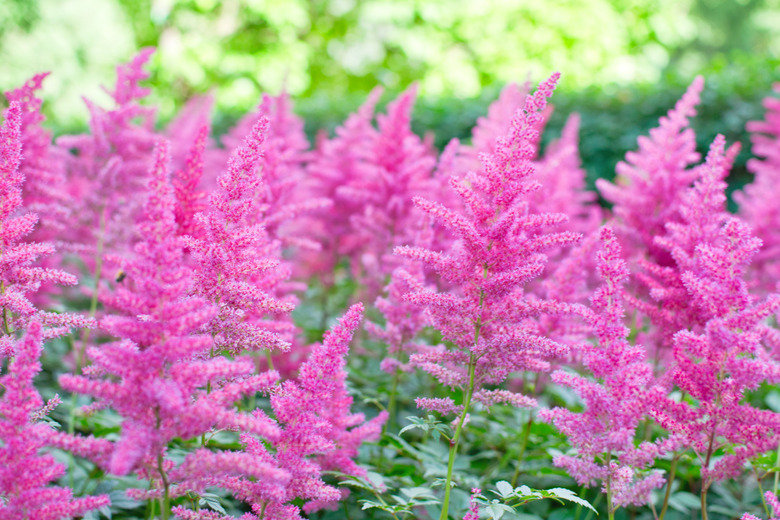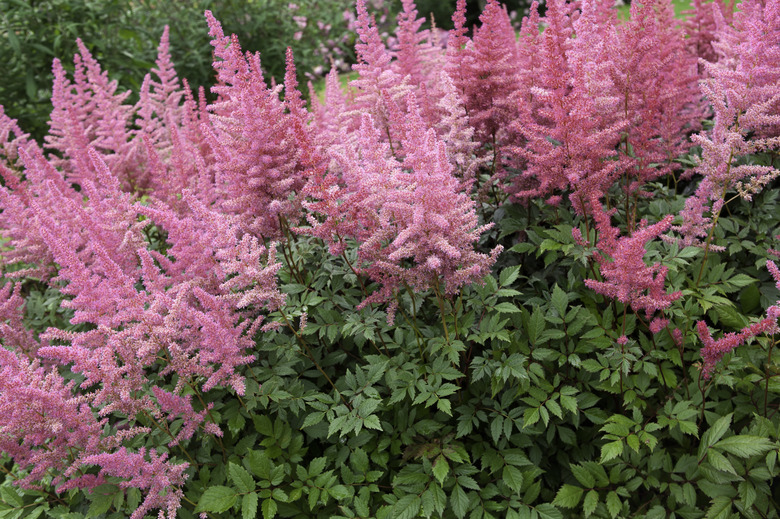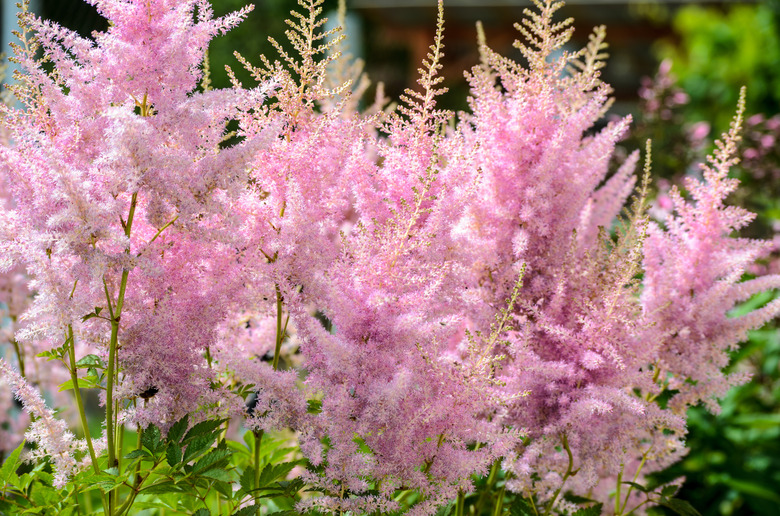How To Grow Astilbe
We may receive a commission on purchases made from links.
Gardeners have a wide selection of perennial flower choices for sunny sites. But for shady garden spots, it's another story. They may start scratching their heads to think of a flowering perennial that offers more than a few tiny flowers for color.
Astilbe (Astilbe spp. [Saxifragaceae]) delivers a two-for-one landscape design punch. Along with their showy and colorful flowers that brighten shady garden nooks, many astilbe plants also command attention because of their dramatic height.
Swaying in the wind, the feathery plumes of astilbe flowers span a color palette in shades of pink, red, purple or white depending on the specific type of plant. One species, Astilbe biternata, is the only North American native astilbe. A perennial in U.S. Department of Agriculture plant hardiness zones 5b through 8a, it's also called "false goat's beard" because of its resemblance to another plant that shares this same common name. This native species has white flowers, and its impressive height of 6 feet generally is taller than other species and cultivars.
In addition to a range of flower colors and plant heights, another diverse characteristic of astilbes is their bloom time. Depending on species and/or cultivar, flowers bloom from spring to summer, but some types, such as Amethyst, may begin blooming in May, while other types, such as 'Cattleya,' don't hit their flowering stride until August or September.
Many enduring astilbe plants in the nursery trade are hybrids that were bred by George Arends. You can identify these hybrid cultivars because this breeder's name is included in the scientific name, for example, Astilbe x arendsii.
Flower colors in this hybrid group include lilac-purple (Astilbe x arendsii 'Amethyst,' zones 4-8), rose (Astilbe x arendsii 'Cattleya,' zones 4-8) and deep red (Astilbe x arendsii 'Fanal,' zones 3-8). 'Amethyst' and 'Cattleya' reach a potential height of 3 feet, which is half the size of the native species, but 'Fanal' is a compact cultivar that typically reaches a height of only 12 inches.
Best Uses for Astilbe
Best Uses for Astilbe
Astilbe flourishes in shady sites where other sun-loving plants decline. It's a superb flowering plant for woodland gardens as well as the shady margins of border gardens or cottage gardens, and it even prospers as a container plant for decks and patios that are sheltered from the sun. Taller astilbe plants are striking as stand-alone specimens in large containers, and shorter types can also be used as a single potted plant or in a mixed container planting.
Because astilbe flowers have such flair, feature astilbe plants with other shade-loving plants that are grown primarily for their foliage, such as hosta (Hosta spp., zones 3-9), coral bells (Heuchera spp., zones 4-9) and Solomon's seal (Polygonatum spp., zones 3-9).
Starting Astilbe From Roots
Starting Astilbe From Roots
Because most astilbe plants in the nursery trade today are hybrids, any seeds they may produce do not come true to the parent plants. As a clumping perennial that multiplies from its roots, astilbe generally is sold as a bare-root plant.
You'll plant astilbe roots in spring just before or after they break dormancy. The roots may already have small sprouts growing from them, or they may only have buds or eyes from which the stems will sprout. You can also dig your own astilbe plants in the fall, divide the roots and plant the divisions. Fan out the roots in a hole that's twice as wide as their spread and plant with the eyes barely peeking through the soil.
If the soil is dry or poor, amend it by working in organic matter such as well-aged manure or compost. After planting the roots, fertilize with an organic 5-5-5 fertilizer. Thoroughly water in the fertilizer around the roots and keep the soil moist.
Best Growing Zones for Astilbe
Best Growing Zones for Astilbe
As a perennial in USDA zones 4 through 9, astilbe grows best when it's protected from direct sun in most of these zones, particularly in warmer climates. At the coldest end of its hardiness range, astilbe can handle a little more sun, but across the warmest limits of this range, plants need protection from afternoon sun. In the South, with its sizzling-hot summers, astilbe also appreciates partial shade or dappled sunlight even in the morning.
Failure to find a properly shaded growing spot can cause astilbe plants to languish from too much sun exposure, even to the point of struggling to meet its flowering potential.
When Should You Plant Astilbe?
When Should You Plant Astilbe?
Plant astilbe as soon as the ground can be worked in spring, which generally falls in mid-April to early May. By making sure you plant well before it heats up in summer, you'll give the roots enough time to become established and better able to support the top growth. A well-developed root system also is able to absorb water and nutrients to nourish plants and maximize their production of flowers.
As an option, you can also plant the roots in fall if your garden is within astilbe's winter-hardy range. This way, the root systems can grow and develop throughout the winter. If you plant in fall, apply a layer of mulch to help insulate the roots.
Soil, Sunlight, and Water Recommendations
Soil, Sunlight, and Water Recommendations
Astilbe is at home in shady locations, which often means under the canopy of trees, particularly in a woodland garden. However, the soil underneath trees is often notoriously hard to work because of the tree roots. A second challenge for planting underneath trees is that astilbe must compete with tree roots for water and nutrients.
Although installing raised beds underneath trees may appear to overcome this challenge, it is not a recommended practice. When you pile soil on top of tree roots, as you would do if installing a raised bed, you're essentially smothering the tree's roots, which must have oxygen to sustain its growth.
A better solution is to prepare an in-ground bed by improving the soil around a tree. Spread several inches of organic matter around a tree and incorporate it into the native soil, a practice that is best accomplished by careful manual digging instead of mechanical cultivation, which can damage the tree's root system.
Astilbe will grow in full shade, but generally, it grows better and produces more flowers when it receives at least a little sunlight each day. Some morning sun is OK, but full sun all day long (or even most of the day) is too much. Another optimal exposure is underneath trees whose leaves filter sunlight throughout the day.
Astilbe plants perform best when the soil is evenly moist. This doesn't mean wet or soggy, and the soil must drain well; instead, it means that the soil doesn't stay completely dry around the root zone. Applying organic mulch around plants, such as finely shredded pine bark, accomplishes a two-pronged goal: It helps keep the soil moist, and it helps keep the soil loose and fertile as it decomposes.
Fertilize astilbe with a light hand. At planting time and in early spring during subsequent years, add 1 to 2 inches of well-aged compost around plants and apply an organic 5-5-5 fertilizer according to label directions. Make a second application of the same fertilizer in early summer.
How to Propagate Astilbe
How to Propagate Astilbe
As astilbe plants grow, their root systems multiply until the plants form a large clump. It's easy to divide these clumps and propagate new plants to transplant elsewhere in your landscape. If you've sited astilbe plants where you want them to grow unrestrained, such as a woodland garden or along a pond's edge, you won't have to divide them unless the plants become so crowded that flowering begins to decline. You may also want to divide your astilbe plants if they grow beyond the boundary of the garden spot you've picked for them.
Dig and divide astilbe clumps every three to four years or whenever they've outgrown their space. If you divide plants early in the season, dig them in early spring when the new growth begins to emerge. If you divide plants late in the season, dig them in fall after they've finished flowering and cut off the foliage before you begin to dig.
Thoroughly water your astilbe plants the day before you plan to divide them and prepare the soil in the new location for the transplants. Gently lift the clumps with a shovel or a long-handled garden fork and cut them into 12-inch-diameter sections with a garden knife or garden shears. Sanitize your cutting tool before making each cut by wiping with or dipping the blade(s) into a 70 percent isopropyl alcohol or ethanol solution.
Immediately plant the divided sections and water them well. Keep the soil moist to help ease the transplanted roots into their new location.
How to Winterize Astilbe
How to Winterize Astilbe
Although you can deadhead the flower plumes earlier in the season after they've finished blooming, many gardeners opt to leave them because they retain much of their color even after they are dry. Before plants go dormant in winter, tidy up their garden area by cutting the foliage and spent flower heads to the ground. If you leave the cut foliage where it falls on the ground, it could harbor pests and disease pathogens over winter, so it's best to remove it.
Common Problems of Astilbe
Common Problems of Astilbe
Astilbe plants are remarkably free of insects, diseases and other pests, including deer and rabbits, which plague many landscape plants. Most problems are a result of cultural or environmental shortcomings, such as too much sun and dry soil, both of which can burn the foliage and, in severe cases, cause plants to die.
Common Diseases for Astilbe
Common Diseases for Astilbe
Two fungal pathogens may occasionally be troublesome for astilbe. Leaf spot, caused by the pathogen Cercospora, and powdery mildew, primarily caused by the pathogen Erysiphe polygoni, affect astilbe foliage. Leaf spot presents as small brown spots that may enlarge and coalesce to form large necrotic areas, and powdery mildew manifests as a white powderlike substance on upper leaf surfaces.
Once you see either of these symptoms, applying a fungicide rarely corrects the problem since fungicides generally work best when applied as a preventive measure (before a disease takes hold) instead of a curative solution. If your astilbe plants contract either of these diseases, apply a preventive fungicide to young plants early the following season, following all label recommendations for rate, time(s), and frequency of application.


